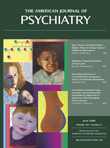Physician-Assisted Suicide
To the Editor: Studies support that psychiatrists’ ethical views on physician-assisted suicide clearly affect their clinical understanding of this practice (1) . This bias is demonstrated in both the manner in which N. Gregory Hamilton, M.D., and Catherine A. Hamilton, M.A. (2) described cases of physician-assisted suicide and the Journal editors’ choice to publish the case report. Dr. and Ms. Hamilton stated that the law failed to protect “Kate Cheney, an 85-year-old cancer patient with growing dementia, whose psychiatrist believed she was being pressured by her family. Nevertheless, she was approved for an overdose by a psychologist” (p. 1061). I was the psychiatrist who determined that Ms. Cheney did not meet the requirements of the law, but concern regarding coercion was not the primary basis. This woman had mild, potentially reversible cognitive deficits that interfered with her ability to understand her options. I agreed with the need for a second opinion and assisted in finding a qualified mental health professional to give one. As noted by Grisso and Appelbaum (3) , “A key element in attempting to maximize patient performance is delaying the final decision about their capacities…repeat evaluations are often helpful in distinguishing between time-limited and permanent impairments” (p. 92).
A second case mentioned was a patient who, according to Dr. and Ms. Hamilton, “also had been diagnosed with depression” (2 , p. 1060) and was given a lethal prescription by Dr. B, “a known assisted suicide activist” (p. 1062). I interviewed (and audiotaped) the internist who made this supposed diagnosis. He clarified that ultimately he did not believe that the patient was depressed. He declined involvement because her “single-mindedness” in obtaining physician-assisted suicide made him uncomfortable. Several other physicians, including a psychiatrist whom I respect and who interviewed the patient and reviewed the case with me, could find no evidence of a DSM-based mood disorder. The only knowledge that Dr. and Ms. Hamilton had of both of these cases appears to be from Oregon newspaper accounts.
I am troubled and perplexed by the Journal ’s choice of this single case report as representative of scientific discourse on physician-assisted suicide and the failure to consider the biases just exemplified. Dr. and Ms. Hamilton published this case with the patients’ and the physicians’ real names on their antieuthanasia website (4) in 2004. Permission was obtained from the family of Kate Cheney for this report in the Journal .
1. Ganzini L, Leong GB, Fenn DS, Silva JA, Weinstock R: Evaluation of competence to consent to assisted suicide: views of forensic psychiatrists. Am J Psychiatry 2000; 157:595–600Google Scholar
2. Hamilton NG, Hamilton CA: Competing paradigms of response to assisted suicide requests in Oregon. Am J Psychiatry 2005; 162:1060–1065Google Scholar
3. Grisso T, Appelbaum PS: Assessing Competence to Consent to Treatment: A Guide for Physicians and Other Health Professionals. New York, Oxford University Press, 1998Google Scholar
4. Competing Paradigms of Responding to Assisted-Suicide Requests in Oregon: A Case Report. http://www.pccef.org/articles/art28Google Scholar



